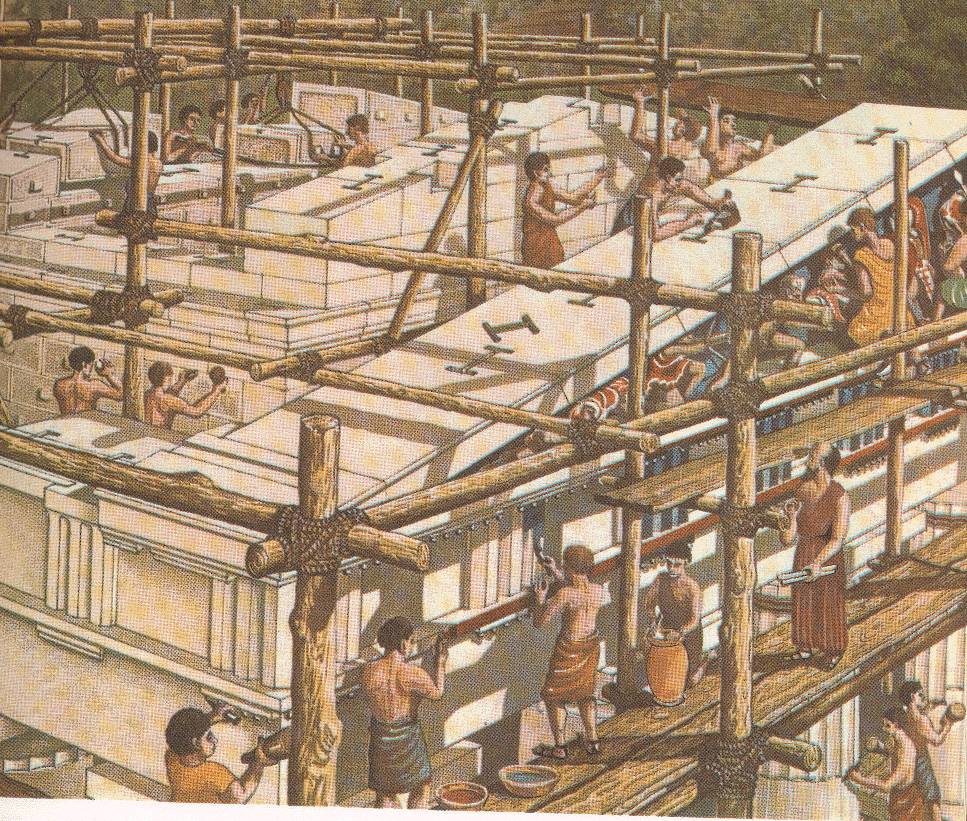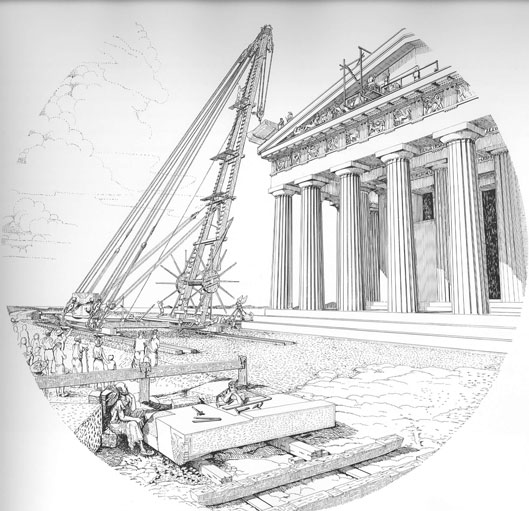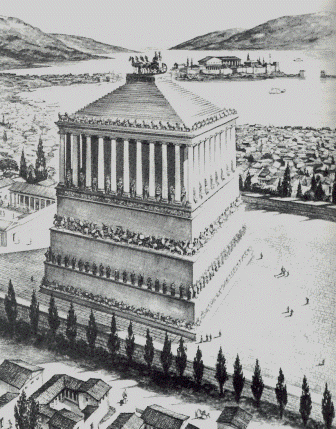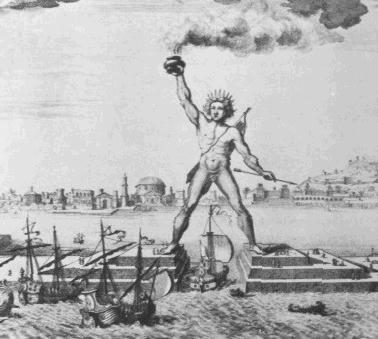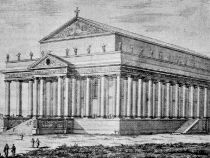Roman Republic
Roman Republic (510 – 100 B.C.E.)
In the history of project management this period was dominated by the Greek and Roman empires in Europe and those of Mauryas in India, and Han in China. From a Project Management perspective construction projects continued to be driven by a temple economy (grain silos held in religious structures) where the ruler initiated communal work projects. These are typically construction projects using stone, brick, and new materials like concrete. There is an increased scientific knowledge specifically with geometry, and more sophisticated equipment like lifts, cranes. The urban revolution continued and saw the development of cities and evolution of city-states. The city-states of Ancient Greece were quarrelsome and fought one another repeatedly with citizens fulfilling military requirements.
Parthenon Athens, Greece, 477-438 BCEGreece was devastated by the Persian invasion of 481 BCE, Athens was sacked and the buildings on the Acropolis demolished. Under the leadership of Athens one hundred Greek city-states joined forces to push back the invaders. Following victory Pericles, the military leader took the initiative to restore the destroyed parts of the city.
The primary objective for Pericles, the principal stakeholder, was to build a magnificent temple, the Parthenon, to architecturally adorn the Acropolis. The Athenians had notions of perfection that they called Symmetria, the harmonious relationship of part to part and of the part to the whole. As part of the project charter the Parthenon was to be an expression of these ideas, a perfectly symmetrical building.
Pericles devised a human resource plan that would utilize the flourishing artistic talent along with the unemployed Athenians, so every Athenian had food on his table. It would keep the unemployed off the streets, and stimulate the Athenian economy by creating important feeder industries by putting the whole city into state-pay. This was an important part of the project charter and it helped get buy-in to the project on a broad scale. Read about how these and other project problems were addressed by the project.
Transporting the marble from the quarry to site was the most significant cost item for the project. Workers cut 100,000 tons of marble, about 70,000 pieces and transported it 16 kilometers (10 miles) to the Acropolis. This was a common trait to most ancient projects. The project was completed 9 years later. Apart from the limestone foundations and the ceilings and wooden doors, the Temple was built entirely of marble, even its roof tiles. The dimensions of the temple at the top step are 30.9 m x 69.5 m (101 ft x 230 ft).
The Parthenon set the pattern for future large-scale projects, or public works. What Pericles achieved went much further as he created one of the most stunning buildings ever built, a massive contribution to Western architecture which was copied for millennia to come. This set the notion it was possible to build esthetically pleasing buildings within the scope of a project budget.
|
|
Great Wall of China, circa 221-206 BCEThe Great Wall of China was a completely different project, punitive in nature. It really was a protracted building program that improved and extended an existing infrastructure. This was done in spurts as the pressure of external invasion mounted. As a result, the project pressed groups into forced labor notably soldiers, and criminals. A point of note is this project had the greatest number of laborers ever used (1,800,000) working on it in a single period.
Transporting the large quantity of materials required for construction was difficult, so builders always tried to use local resources. Stones from the mountains were used over mountain ranges, while rammed earth was used for construction in the plains. In the deserts, sanded reeds and juniper tamarisks were put to use. |
|
|
Seven Wonders of the Ancient WorldThis period covers structures like temples, mausoleums, statues, buildings, and towers including five of these . The list is very subjective as few of these wonders (the project output) remain today, and details about the projects are scant and only now coming to light through archaeology. The most astonishing fact about these projects is the scale of the deliverable (the construct itself) considering the main resource available was human capital.
Mausoleum at Halicarnassus, 353 BCEThe Mausoleum at Halicarnassus was almost square, 125 m (411 ft) and bounded by 36 columns. The top formed a 24-step pyramid surmounted by a four-horse marble chariot with base dimensions of about 40 m x 30 m (120 ft x 100 ft). The total height was 45 m (140 ft).
|
|
Colossus of Rhodes, 304 BCEThe Colossus of Rhodes which stood 45 m (150 ft) high and upon a 12 m (50 ft) pedestal near the harbor mole, was constructed in 12 years. Although the statue has been popularly depicted with its legs spanning the harbor entrance so that ships could pass beneath, it was actually posed in a more traditional Greek manner. The Statue of Liberty is roughly of the same size but built 2000 years later. |
|
Lighthouse of Alexandria, 270 BCEThe total height of the Lighthouse of Alexandria, including the foundation, was 117 m (384 ft), equivalent to a 40-story modern building, phenomenally high. It guided sailors into the city harbor for 1,500 years and was the last of the six lost wonders to disappear. A shaft in the internal core lifted fuel for the fire used during the night otherwise a mirror reflected sunlight during the day, and this could be seen more than 50 km (35 mi) off-shore. Like the structure of an early twentieth century skyscraper there were 3 stages. The building was constructed of marble blocks with lead mortar. The lowest level was probably more that 60 m (200) ft in height and 30 m (100 ft) square with a large spiral ramp that allowed materials to be pulled to the top in horse-drawn carts. A statue of Poseidon adorned the summit of the building. It is likely that like many other ancient buildings, it was the victim of earthquakes. |
 |
Statue of Zeus at Olympia, circa 2nd centuryThe Statue of Zeus at Olympia where the base of the statue was about 6.5 m (20 ft) wide and 1.0 meter (3 ft) high. The height of the statue was 13 m (40 ft), equivalent to a modern 4-story building. The Olympic Games, in honor of the King of the gods, were first started in 776 BC and were held at the shrine to Zeus. Zeus had a scepter of a multicolored alloy of rare metals. He was crowned with an eagle's head symbolizing his rule over the earth. His right hand supported a life-size statue of Nike, the goddess of victory, and the stool beneath his feet was made of two gold lions. His hair, beard, and drapery were made of gold, and his unclothed flesh—head, hands and feet—was rendered in burnished ivory which was regularly anointed with olive oil to prevent cracking. |
|
|
Temple of Artemis at Ephesus, 262The Temple of Artemis at Ephesus was approximately 80 m x 130 m (260 ft x 430 ft) in plan. The 127 columns in total were 20 m (66 ft) high with Ionic capitals and carved circular sides. Artemisia decided that no expense was to be spared in the building of the tomb and she sent messengers to Greece to find the most talented artists of the time as well as hundreds of other craftsmen. |
|

